Applications of Digital Technologies in Promoting Sustainable Construction Practices: A Literature Review
Abstract
1. Introduction
2. Methodology
2.1. Database Selection and Paper Retrieval
2.2. Software Selection
3. Basic Situation Analysis
3.1. Annual Publishing Trend
3.2. Journal Analysis
3.2.1. Journal Quantity Analysis
3.2.2. Journal Co-Citation Analysis
3.3. Cooperation Network Analysis
4. Knowledge Base Analysis
4.1. Barriers
4.2. Energy Efficiency and Building Energy Performance
4.3. Life Cycle Assessment
4.4. Computer Vision
4.5. Renovation
4.6. Building Sustainability Assessment
4.7. Management
5. Current Research Hotspots
5.1. Environmental Performance
5.2. Economic Performance
5.3. Social Performance
5.4. Green Building Assessment
6. Future Research Directions
6.1. Strengthening Research on the Application of More Digital Technologies
6.2. Expanding the Use of Digital Technologies in O & M and Demolition Phases
6.3. Deepening the Research on Multi-Objective Optimization
6.4. Exploring How to Overcome Obstacles
7. Conclusions
Author Contributions
Funding
Conflicts of Interest
References
- Hamelink, C.J. New Information and Communication Technologies, Social Development and Cultural Change; United Nations Research Institute for Social Development: Geneva, Switzerland, 1997. [Google Scholar]
- Ciarli, T.; Kenney, M.; Massini, S.; Piscitello, L. Digital technologies, innovation, and skills: Emerging trajectories and challenges. Res. Policy 2021, 50, 104289. [Google Scholar] [CrossRef]
- Wu, T.; He, S.; Liu, J.; Sun, S.; Liu, K.; Han, Q.-L. A brief overview of ChatGPT: The history, status quo and potential future development. IEEE-CAA J. Autom. Sin. 2023, 10, 1122–1136. [Google Scholar] [CrossRef]
- Haleem, A.; Javaid, M.; Qadri, M.A.; Suman, R. Understanding the role of digital technologies in education: A review. Sustain. Oper. Comput. 2022, 3, 275–285. [Google Scholar] [CrossRef]
- Ansah, M.K.; Chen, X.; Yang, H.; Lu, L.; Lam, P.T.I. A review and outlook for integrated BIM application in green building assessment. Sustain. Cities Soc. 2019, 48, 101576. [Google Scholar] [CrossRef]
- Li, L.; Yi, Z.; Jiang, F.; Zhang, S.; Zhou, J. Exploring the mechanism of digital transformation empowering green innovation in construction enterprises. Dev. Built Environ. 2023, 15, 100199. [Google Scholar] [CrossRef]
- Eleftheriadis, S.; Duffour, P.; Mumovic, D. BIM-embedded life cycle carbon assessment of RC buildings using optimised structural design alternatives. Energy Build. 2018, 173, 587–600. [Google Scholar] [CrossRef]
- Liu, S.; Meng, X.; Tam, C. Building information modeling based building design optimization for sustainability. Energy Build. 2015, 105, 139–153. [Google Scholar] [CrossRef]
- Shadram, F.; Johansson, T.D.; Lu, W.Z.; Schade, J.; Olofsson, T. An integrated BIM-based framework for minimizing embodied energy during building design. Energy Build. 2016, 128, 592–604. [Google Scholar] [CrossRef]
- Yang, Z.; Zhu, C.; Zhu, Y.; Li, X. Blockchain technology in building environmental sustainability: A systematic literature review and future perspectives. Build. Environ. 2023, 245, 110970. [Google Scholar] [CrossRef]
- Li, Y.; Li, M.; Sang, P. A bibliometric review of studies on construction and demolition waste management by using CiteSpace. Energy Build. 2022, 258, 111822. [Google Scholar] [CrossRef]
- Lima, L.; Trindade, E.; Alencar, L.; Alencar, M.; Silva, L. Sustainability in the construction industry: A systematic review of the literature. J. Clean. Prod. 2021, 289, 125730. [Google Scholar] [CrossRef]
- Ibem, E.O.; Laryea, S. Survey of digital technologies in procurement of construction projects. Autom. Constr. 2014, 46, 11–21. [Google Scholar] [CrossRef]
- Chowdhury, T.; Adafin, J.; Wilkinson, S. Review of digital technologies to improve productivity of New Zealand construction industry. J. Inf. Technol. Constr. 2019, 24, 569–587. [Google Scholar]
- Abioye, S.O.; Oyedele, L.O.; Akanbi, L.; Ajayi, A.; Davila Delgado, J.M.; Bilal, M.; Akinade, O.O.; Ahmed, A. Artificial intelligence in the construction industry: A review of present status, opportunities and future challenges. J. Build. 2021, 44, 103299. [Google Scholar] [CrossRef]
- Luo, H.; Lin, L.; Chen, K.; Antwi-Afari, M.F.; Chen, L. Digital technology for quality management in construction: A review and future research directions. Dev. Built Environ. 2022, 12, 100087. [Google Scholar] [CrossRef]
- Wang, M.; Wang, C.C.; Sepasgozar, S.; Zlatanova, S. A systematic review of digital technology adoption in off-site construction: Current status and future direction towards industry 4.0. Buildings 2020, 10, 204. [Google Scholar] [CrossRef]
- Opoku, D.-G.J.; Perera, S.; Osei-Kyei, R.; Rashidi, M. Digital twin application in the construction industry: A literature review. J. Build. Eng. 2021, 40, 102726. [Google Scholar] [CrossRef]
- Olawumi, T.O.; Chan, D.W.; Ojo, S.; Yam, M.C. Automating the modular construction process: A review of digital technologies and future directions with blockchain technology. J. Build. Eng. 2022, 46, 103720. [Google Scholar] [CrossRef]
- Cascone, S. Digital technologies and sustainability assessment: A critical review on the integration methods between BIM and LEED. Sustainability 2023, 15, 5548. [Google Scholar] [CrossRef]
- Trask, C.; Linderoth, H.C. Digital technologies in construction: A systematic mapping review of evidence for improved occupational health and safety. J. Build. Eng. 2023, 80, 108082. [Google Scholar] [CrossRef]
- Iyiola, C.O.; Shakantu, W.; Daniel, E.I. Digital Technologies for Promoting Construction and Demolition Waste Management: A Systematic Review. Buildings 2024, 14, 3234. [Google Scholar] [CrossRef]
- Li, K.; Rollins, J.; Yan, E. Web of Science use in published research and review papers 1997–2017: A selective, dynamic, cross-domain, content-based analysis. Scientometrics 2018, 115, 1–20. [Google Scholar] [CrossRef] [PubMed]
- Li, Y.; Li, M.; Sang, P.; Chen, P.-H.; Li, C. Stakeholder studies of green buildings: A literature review. J. Build. 2022, 54, 104667. [Google Scholar] [CrossRef]
- Li, Y.; Wang, Y.; Wang, R.; Liu, C.; Zhang, Z. Bibliometric Review of Research on Green Building Assessment Method by Citespace and Histcite. Int. J. Strateg. Prop. Manag. 2024, 28, 177–193. [Google Scholar] [CrossRef]
- Wang, L.; Chen, Y.; Ramsey, T.S.; Hewings, G.J.D. Will researching digital technology really empower green development? Technol. Soc. 2021, 66, 101638. [Google Scholar] [CrossRef]
- Zhong, B.; Wu, H.; Li, H.; Sepasgozar, S.; Luo, H.; He, L. A scientometric analysis and critical review of construction related ontology research. Autom. Constr. 2019, 101, 17–31. [Google Scholar] [CrossRef]
- Zhao, X.; Zuo, J.; Wu, G.; Huang, C. A bibliometric review of green building research 2000–2016. Archit. Sci. Rev. 2019, 62, 74–88. [Google Scholar] [CrossRef]
- Rousseeuw, P. Silhouettes: A graphical aid to the interpretation and validation of cluster analysis. J. Comput. Appl. Math. 1987, 20, 53–65. [Google Scholar] [CrossRef]
- Takyi-Annan, G.E.; Zhang, H. Assessing the impact of overcoming BIM implementation barriers on BIM usage frequency and circular economy in the project lifecycle using Partial least Squares structural Equation modelling (PLS-SEM) analysis. Energy Build. 2023, 295, 113329. [Google Scholar] [CrossRef]
- Wuni, I.Y.; Abankwa, D.A.; Koc, K.; Adukpo, S.E.; Antwi-Afari, M.F. Critical barriers to the adoption of integrated digital delivery in the construction industry. J. Build. 2024, 83, 108474. [Google Scholar] [CrossRef]
- Asif, M.; Naeem, G.; Khalid, M. Digitalization for sustainable buildings: Technologies, applications, potential, and challenges. J. Clean. Prod. 2024, 450, 141814. [Google Scholar] [CrossRef]
- AlBalkhy, W.; Karmaoui, D.; Ducoulombier, L.; Lafhaj, Z.; Linner, T. Digital twins in the built environment: Definition, applications, and challenges. Autom. Constr. 2024, 162, 105368. [Google Scholar] [CrossRef]
- Kumar Singh, A.; Kumar, V.R.P.; Dehdasht, G.; Mohandes, S.R.; Manu, P.; Pour Rahimian, F. Investigating the barriers to the adoption of blockchain technology in sustainable construction projects. J. Clean. Prod. 2023, 403, 136840. [Google Scholar] [CrossRef]
- Kineber, A.F.; Singh, A.K.; Fazeli, A.; Mohandes, S.R.; Cheung, C.; Arashpour, M.; Ejohwomu, O.; Zayed, T. Modelling the relationship between digital twins implementation barriers and sustainability pillars: Insights from building and construction sector. Sustain. Cities Soc. 2023, 99, 104930. [Google Scholar] [CrossRef]
- Zhan, H.; Hwang, B.-G.; Zhu, H.; Ang, S.H.P. Towards a sustainable built environment industry in Singapore: Drivers, barriers, and strategies in the adoption of smart facilities management. J. Clean. Prod. 2023, 425, 138726. [Google Scholar] [CrossRef]
- Jiang, P.; Zhang, L.; You, S.; Fan, Y.V.; Tan, R.R.; Klemeš, J.J.; You, F. Blockchain technology applications in waste management: Overview, challenges and opportunities. J. Clean. Prod. 2023, 421, 138466. [Google Scholar] [CrossRef]
- Dahiya, D.; Laishram, B. Life cycle energy analysis of buildings: A systematic review. Build. Environ. 2024, 252, 111160. [Google Scholar] [CrossRef]
- Fokaides, P.A.; Apanaviciene, R.; Černeckiene, J.; Jurelionis, A.; Klumbyte, E.; Kriauciunaite-Neklejonoviene, V.; Pupeikis, D.; Rekus, D.; Sadauskiene, J.; Seduikyte, L.; et al. Research Challenges and Advancements in the field of Sustainable Energy Technologies in the Built Environment. Sustainability 2020, 12, 8417. [Google Scholar] [CrossRef]
- Gan, V.J.L.; Lo, I.M.C.; Ma, J.; Tse, K.T.; Cheng, J.C.P.; Chan, C.M. Simulation optimisation towards energy efficient green buildings: Current status and future trends. J. Clean. Prod. 2020, 254, 120012. [Google Scholar] [CrossRef]
- Omrany, H.; Ghaffarianhoseini, A.; Chang, R.D.; Ghaffarianhoseini, A.; Pour Rahimian, F. Applications of Building information modelling in the early design stage of high-rise buildings. Autom. Constr. 2023, 152, 104934. [Google Scholar] [CrossRef]
- Sovetova, M.; Kaiser Calautit, J. Thermal and energy efficiency in 3D-printed buildings: Review of geometric design, materials and printing processes. Energy Build. 2024, 323, 11431. [Google Scholar] [CrossRef]
- Lai, K.E.; Abdul Rahiman, N.; Othman, N.; Ali, K.N.; Lim, Y.W.; Moayedi, F.; Dzahir, M.A.M. Quantification process of carbon emissions in the construction industry. Energy Build. 2023, 289, 113025. [Google Scholar] [CrossRef]
- Santos, R.; Costa, A.A.; Silvestre, J.D.; Pyl, L. Integration of LCA and LCC analysis within a BIM-based environment. Autom. Constr. 2019, 103, 127–149. [Google Scholar] [CrossRef]
- Khan, S.A.; Koç, M.; Al-Ghamdi, S.G. Sustainability assessment, potentials and challenges of 3D printed concrete structures: A systematic review for built environmental applications. J. Clean. Prod. 2021, 303, 127027. [Google Scholar] [CrossRef]
- Tinoco, M.P.; de Mendonça, É.M.; Fernandez, L.I.C.; Caldas, L.R.; Reales, O.A.M.; Toledo Filho, R.D. Life cycle assessment (LCA) and environmental sustainability of cementitious materials for 3D concrete printing: A systematic literature review. J. Build. 2022, 52, 104456. [Google Scholar] [CrossRef]
- Kristoffersen, A.E.; Schultz, C.P.L.; Kamari, A. A critical comparison of concepts and approaches to social sustainability in the construction industry. J. Build. 2024, 91, 109530. [Google Scholar] [CrossRef]
- Pan, Y.; Zhang, L. Roles of artificial intelligence in construction engineering and management: A critical review and future trends. Autom. Constr. 2021, 122, 103517. [Google Scholar] [CrossRef]
- Wang, T.; Gan, V.J.L. Automated joint 3D reconstruction and visual inspection for buildings using computer vision and transfer learning. Autom. Constr. 2023, 149, 104810. [Google Scholar] [CrossRef]
- Dino, I.G.; Sari, A.E.; Iseri, O.K.; Akin, S.; Kalfaoglu, E.; Erdogan, B.; Kalkan, S.; Alatan, A.A. Image-based construction of building energy models using computer vision. Autom. Constr. 2020, 116, 103231. [Google Scholar] [CrossRef]
- Fang, W.; Love, P.E.D.; Luo, H.; Ding, L. Computer vision for behaviour-based safety in construction: A review and future directions. Adv. Eng. Inform. 2020, 43, 100980. [Google Scholar] [CrossRef]
- Wang, J.Q.; Jiang, L.F.; Yu, H.H.; Feng, Z.B.; Castaño-Rosa, R.; Cao, S.-J. Computer vision to advance the sensing and control of built environment towards occupant-centric sustainable development: A critical review. Renew. Sustain. Energy Rev. 2024, 192, 114165. [Google Scholar] [CrossRef]
- Liao, H.; Ren, R.; Li, L. Existing building renovation: A review of barriers to economic and environmental benefits. Int. J. Environ. Res. Public Health 2023, 20, 4058. [Google Scholar] [CrossRef] [PubMed]
- Stegnar, G.; Cerovšek, T. Information needs for progressive BIM methodology supporting the holistic energy renovation of office buildings. Energy 2019, 173, 317–331. [Google Scholar] [CrossRef]
- Tang, W. Application of BIM technology in the reinforcement and renovation of existing building inspection projects. Alex. Eng. J. 2023, 82, 240–247. [Google Scholar] [CrossRef]
- Carvalho, J.P.; Bragança, L.; Mateus, R. Automating building sustainability assessment using building information modelling: A case study. J. Build. 2023, 76, 107228. [Google Scholar] [CrossRef]
- Carvalho, J.P.; Bragança, L.; Mateus, R. Optimising building sustainability assessment using BIM. Autom. Constr. 2019, 102, 170–182. [Google Scholar] [CrossRef]
- Huang, B.; Lei, J.; Ren, F.; Chen, Y.; Zhao, Q.; Li, S.; Lin, Y. Contribution and obstacle analysis of applying BIM in promoting green buildings. J. Clean. Prod. 2021, 278, 123946. [Google Scholar] [CrossRef]
- Jayasanka, T.; Darko, A.; Edwards, D.; Chan, A.P.; Jalaei, F. Automating building environmental assessment: A systematic review and future research directions. Environ. Impact Assess. Rev. 2024, 106, 107465. [Google Scholar] [CrossRef]
- Li, Y.; Song, H.; Sang, P.; Chen, P.-H.; Liu, X. Review of Critical Success Factors (CSFs) for green building projects. Build. Environ. 2019, 158, 182–191. [Google Scholar] [CrossRef]
- Adu-Amankwa, N.A.N.; Pour Rahimian, F.; Dawood, N.; Park, C. Digital Twins and Blockchain technologies for building lifecycle management. Autom. Constr. 2023, 155, 105064. [Google Scholar] [CrossRef]
- Zhang, T.; Doan, D.T.; Kang, J. Application of building information modeling-blockchain integration in the Architecture, Engineering, and Construction/Facilities Management industry: A review. J. Build. 2023, 77, 107551. [Google Scholar] [CrossRef]
- Schamne, A.N.; Nagalli, A.; Soeiro, A.A.V.; Poças Martins, J.P.d.S. BIM in construction waste management: A conceptual model based on the industry foundation classes standard. Autom. Constr. 2024, 159, 105283. [Google Scholar] [CrossRef]
- Pellegrini, L.; Campi, S.; Locatelli, M.; Pattini, G.; Di Giuda, G.M.; Tagliabue, L.C. Digital Transition and Waste Management in Architecture, Engineering, Construction, and Operations Industry. Front. Energy Res. 2020, 8, 576462. [Google Scholar] [CrossRef]
- Wong, J.K.-W.; Kuan, K.-L. Implementing ‘BEAM Plus’ for BIM-based sustainability analysis. Autom. Constr. 2014, 44, 163–175. [Google Scholar] [CrossRef]
- Kota, S.; Haberl, J.S.; Clayton, M.J.; Yan, W. Building Information Modeling (BIM)-based daylighting simulation and analysis. Energy Build. 2014, 81, 391–403. [Google Scholar] [CrossRef]
- Ham, Y.; Golparvar-Fard, M. Mapping actual thermal properties to building elements in gbXML-based BIM for reliable building energy performance modeling. Autom. Constr. 2015, 49, 214–224. [Google Scholar] [CrossRef]
- Jalaei, F.; Jrade, A. Integrating building information modeling (BIM) and LEED system at the conceptual design stage of sustainable buildings. Sustain. Cities Soc. 2015, 18, 95–107. [Google Scholar] [CrossRef]
- Lee, S.; Tae, S.; Roh, S.; Kim, T. Green Template for Life Cycle Assessment of Buildings Based on Building Information Modeling: Focus on Embodied Environmental Impact. Sustainability 2015, 7, 16498–16512. [Google Scholar] [CrossRef]
- Rahmani Asl, M.; Zarrinmehr, S.; Bergin, M.; Yan, W. BPOpt: A framework for BIM-based performance optimization. Energy Build. 2015, 108, 401–412. [Google Scholar] [CrossRef]
- Abanda, F.H.; Byers, L. An investigation of the impact of building orientation on energy consumption in a domestic building using emerging BIM (Building Information Modelling). Energy 2016, 97, 517–527. [Google Scholar] [CrossRef]
- Ilhan, B.; Yaman, H. Green building assessment tool (GBAT) for integrated BIM-based design decisions. Autom. Constr. 2016, 70, 26–37. [Google Scholar] [CrossRef]
- GhaffarianHoseini, A.; Tien Doan, D.; Naismith, N.; Tookey, J.; GhaffarianHoseini, A. Amplifying the practicality of contemporary building information modelling (BIM) implementations for New Zealand green building certification (Green Star). Eng. Constr. Archit. Manag. 2017, 24, 696–714. [Google Scholar] [CrossRef]
- Alwan, Z.; Jones, P.; Holgate, P. Strategic sustainable development in the UK construction industry, through the framework for strategic sustainable development, using Building Information Modelling. J. Clean. Prod. 2017, 140, 349–358. [Google Scholar] [CrossRef]
- GhaffarianHoseini, A.; Tookey, J.; GhaffarianHoseini, A. Application of nD BIM Integrated Knowledge-based Building Management System (BIM-IKBMS) for inspecting post-construction energy efficiency. Renew. Sustain. Energy Rev. 2017, 72, 935–945. [Google Scholar] [CrossRef]
- Habibi, S. The promise of BIM for improving building performance. Energy Build. 2017, 153, 525–548. [Google Scholar] [CrossRef]
- Najjar, M.; Figueiredo, K.; Palumbo, M.; Haddad, A. Integration of BIM and LCA: Evaluating the environmental impacts of building materials at an early stage of designing a typical office building. J. Build. 2017, 14, 115–126. [Google Scholar] [CrossRef]
- Panda, B.; Paul, S.C.; Hui, L.J.; Tay, Y.W.D.; Tan, M.J. Additive manufacturing of geopolymer for sustainable built environment. J. Clean. Prod. 2017, 167, 281–288. [Google Scholar] [CrossRef]
- Panda, B.; Chandra Paul, S.; Jen Tan, M. Anisotropic mechanical performance of 3D printed fiber reinforced sustainable construction material. Mater. Lett. 2017, 209, 146–149. [Google Scholar] [CrossRef]
- Shadram, F.; Mukkavaara, J. An integrated BIM-based framework for the optimization of the trade-off between embodied and operational energy. Energy Build. 2018, 158, 1189–1205. [Google Scholar] [CrossRef]
- Nizam, R.S.; Zhang, C.; Tian, L. A BIM based tool for assessing embodied energy for buildings. Energy Build. 2018, 170, 1–14. [Google Scholar] [CrossRef]
- Marzouk, M.; Azab, S.; Metawie, M. BIM-based approach for optimizing life cycle costs of sustainable buildings. J. Clean. Prod. 2018, 188, 217–226. [Google Scholar] [CrossRef]
- Yang, X.; Hu, M.; Wu, J.; Zhao, B. Building-information-modeling enabled life cycle assessment, a case study on carbon footprint accounting for a residential building in China. J. Clean. Prod. 2018, 183, 729–743. [Google Scholar] [CrossRef]
- Bueno, C.; Fabricio, M.M. Comparative analysis between a complete LCA study and results from a BIM-LCA plug-in. Autom. Constr. 2018, 90, 188–200. [Google Scholar] [CrossRef]
- Olawumi, T.O.; Chan, D.W.M. Identifying and prioritizing the benefits of integrating BIM and sustainability practices in construction projects: A Delphi survey of international experts. Sustain. Cities Soc. 2018, 40, 16–27. [Google Scholar] [CrossRef]
- Gan, V.J.L.; Deng, M.; Tse, K.T.; Chan, C.M.; Lo, I.M.C.; Cheng, J.C.P. Holistic BIM framework for sustainable low carbon design of high-rise buildings. J. Clean. Prod. 2018, 195, 1091–1104. [Google Scholar] [CrossRef]
- Panda, B.; Unluer, C.; Tan, M.J. Investigation of the rheology and strength of geopolymer mixtures for extrusion-based 3D printing. Cem. Concr. Compos. 2018, 94, 307–314. [Google Scholar] [CrossRef]
- Olawumi, T.O.; Chan, D.W.M.; Wong, J.K.W.; Chan, A.P.C. Barriers to the integration of BIM and sustainability practices in construction projects: A Delphi survey of international experts. J. Build. 2018, 20, 60–71. [Google Scholar] [CrossRef]
- Rezaei, F.; Bulle, C.; Lesage, P. Integrating building information modeling and life cycle assessment in the early and detailed building design stages. Build. Environ. 2019, 153, 158–167. [Google Scholar] [CrossRef]
- Lu, Y.; Wu, Z.; Chang, R.; Li, Y. Building Information Modeling (BIM) for green buildings: A critical review and future directions. Autom. Constr. 2017, 83, 134–148. [Google Scholar] [CrossRef]
- Edirisinghe, R. Digital skin of the construction site Smart sensor technologies towards the future smart construction site. Eng. Constr. Archit. Manag. 2019, 26, 184–223. [Google Scholar] [CrossRef]
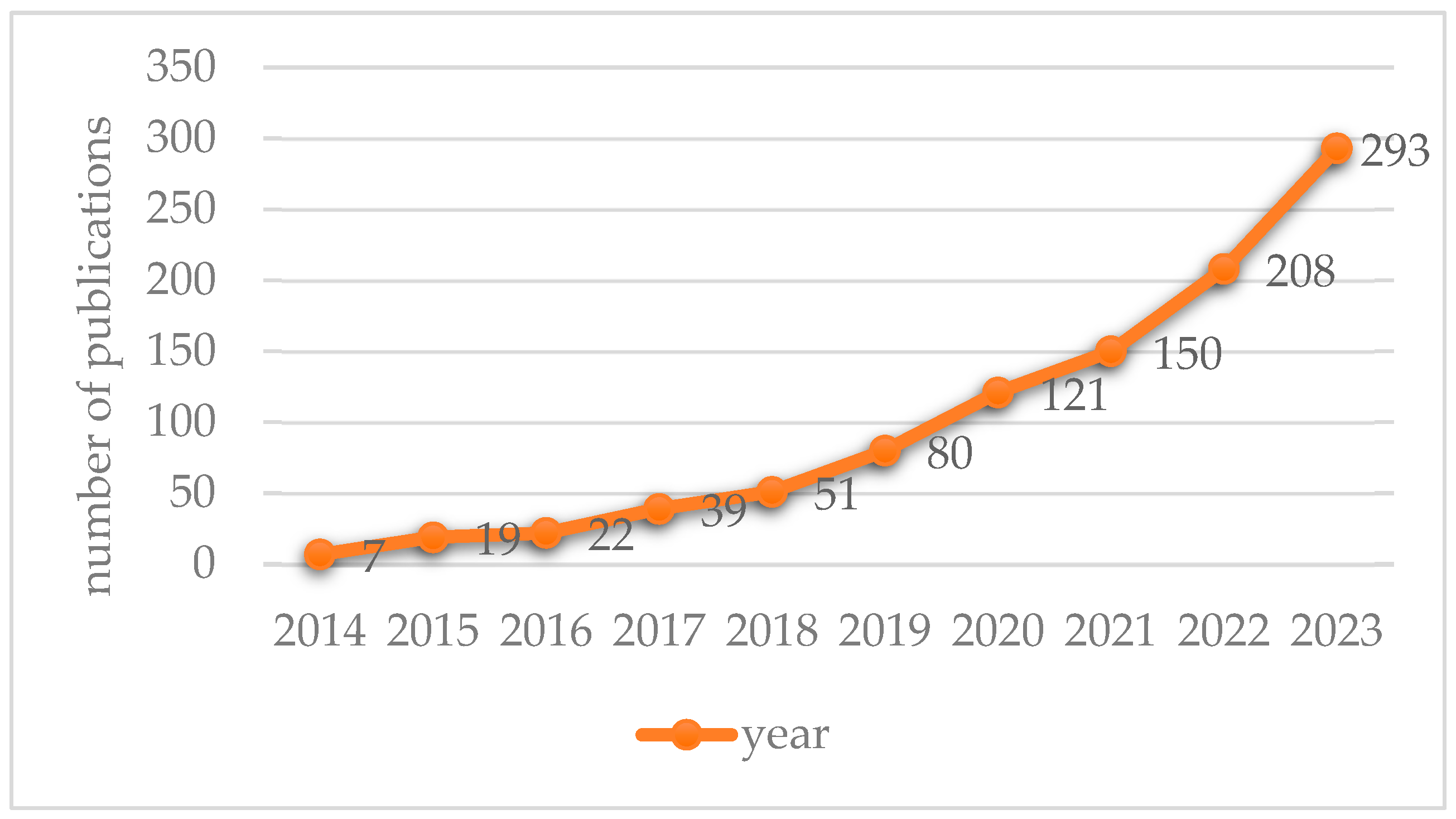

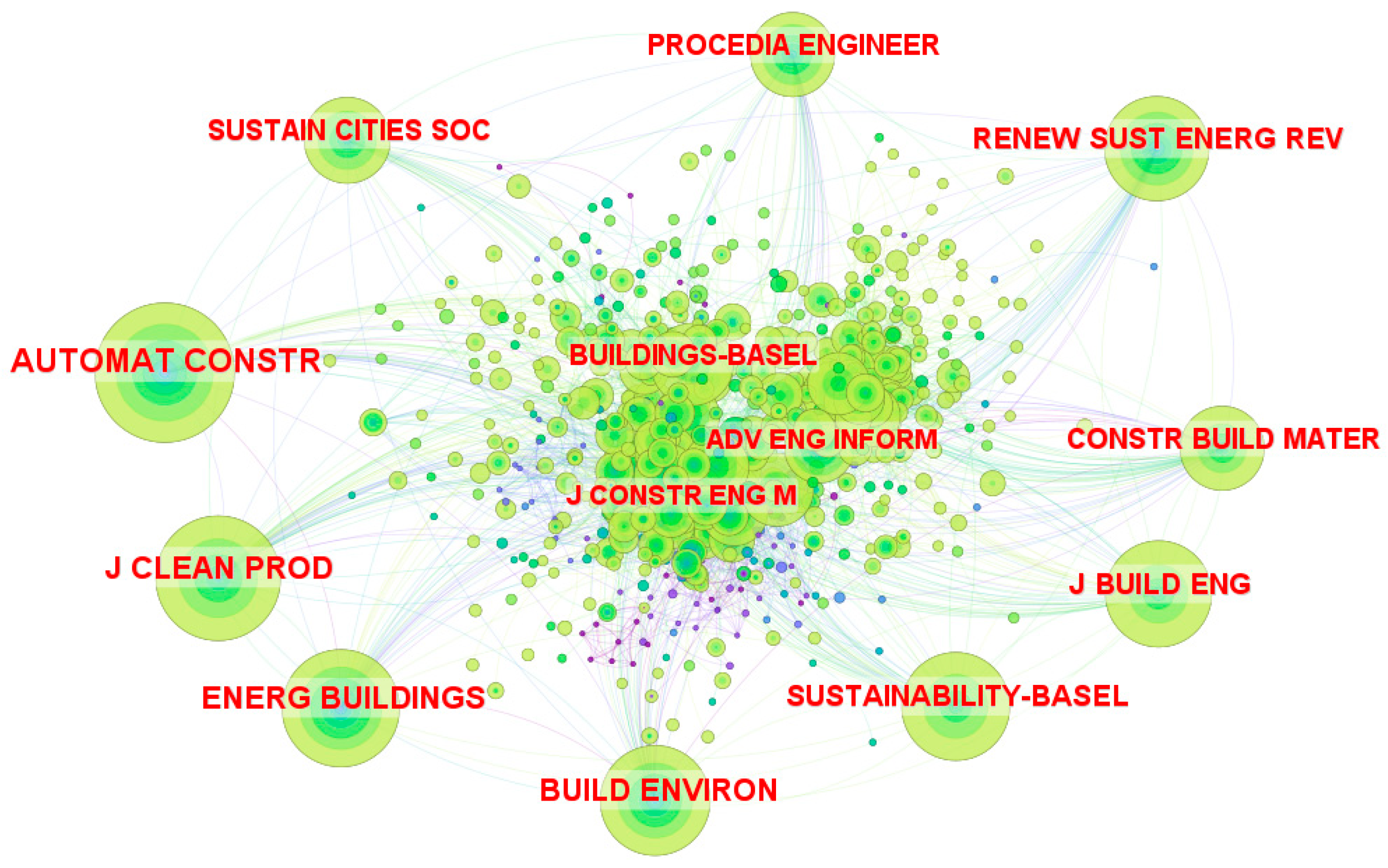
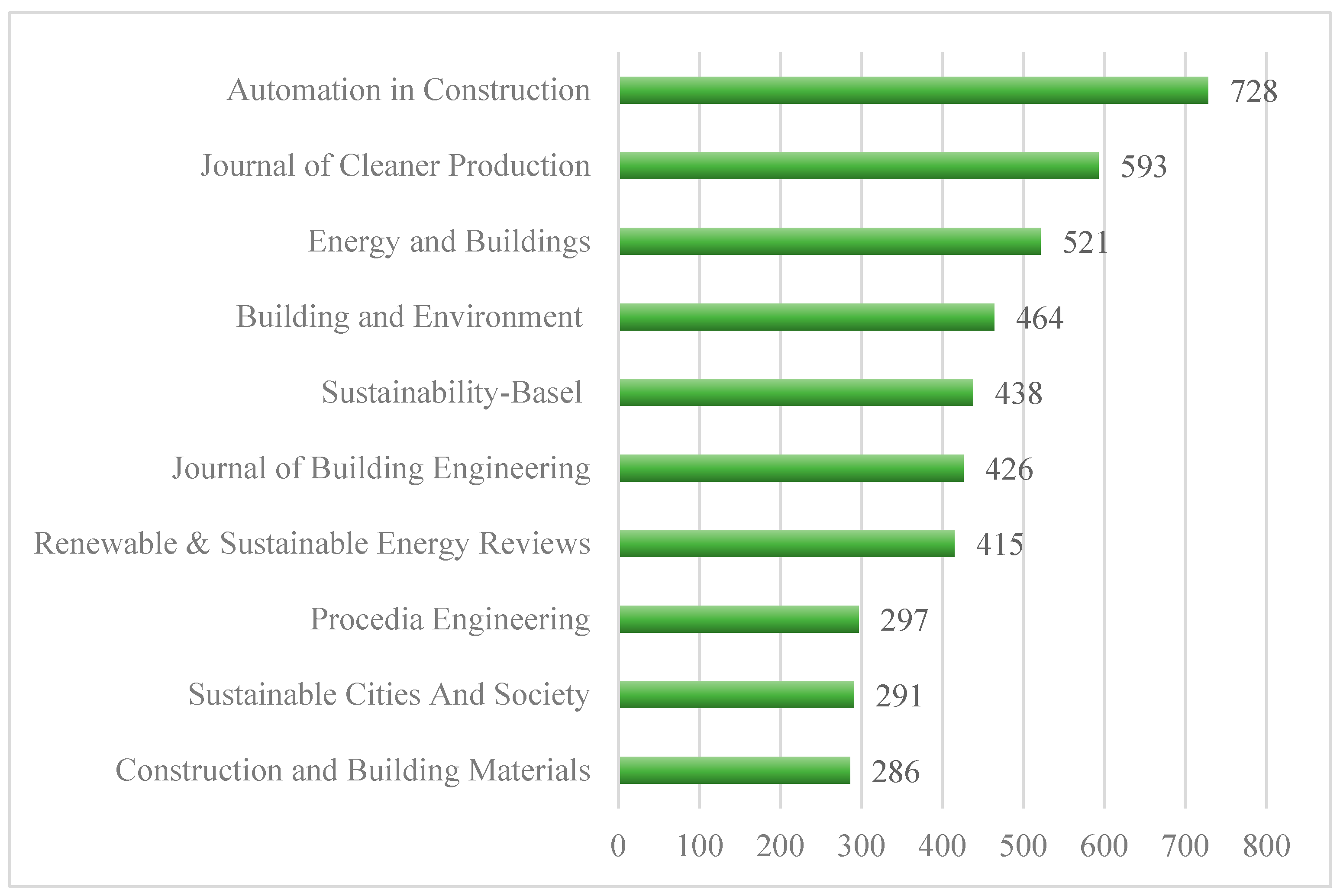
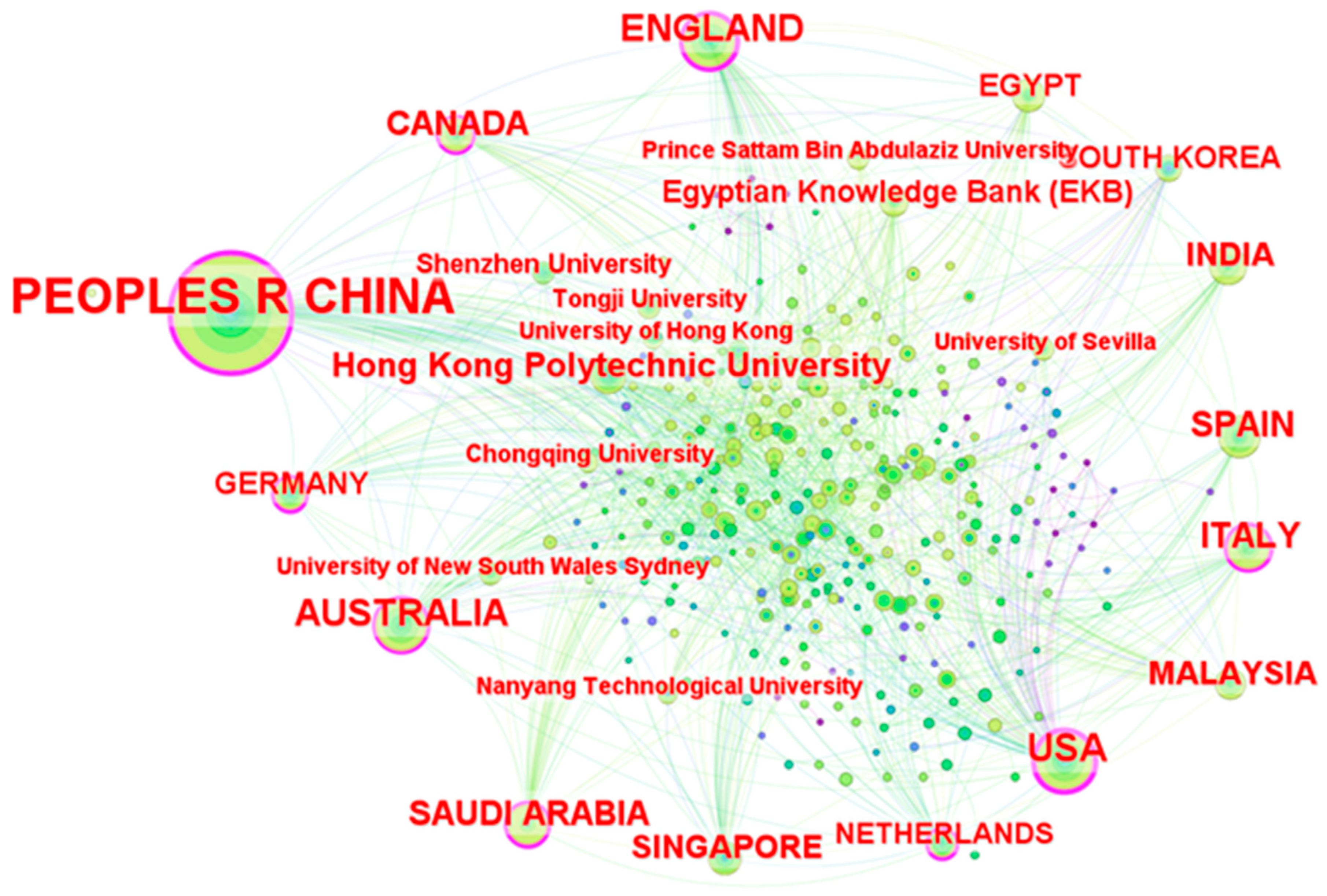

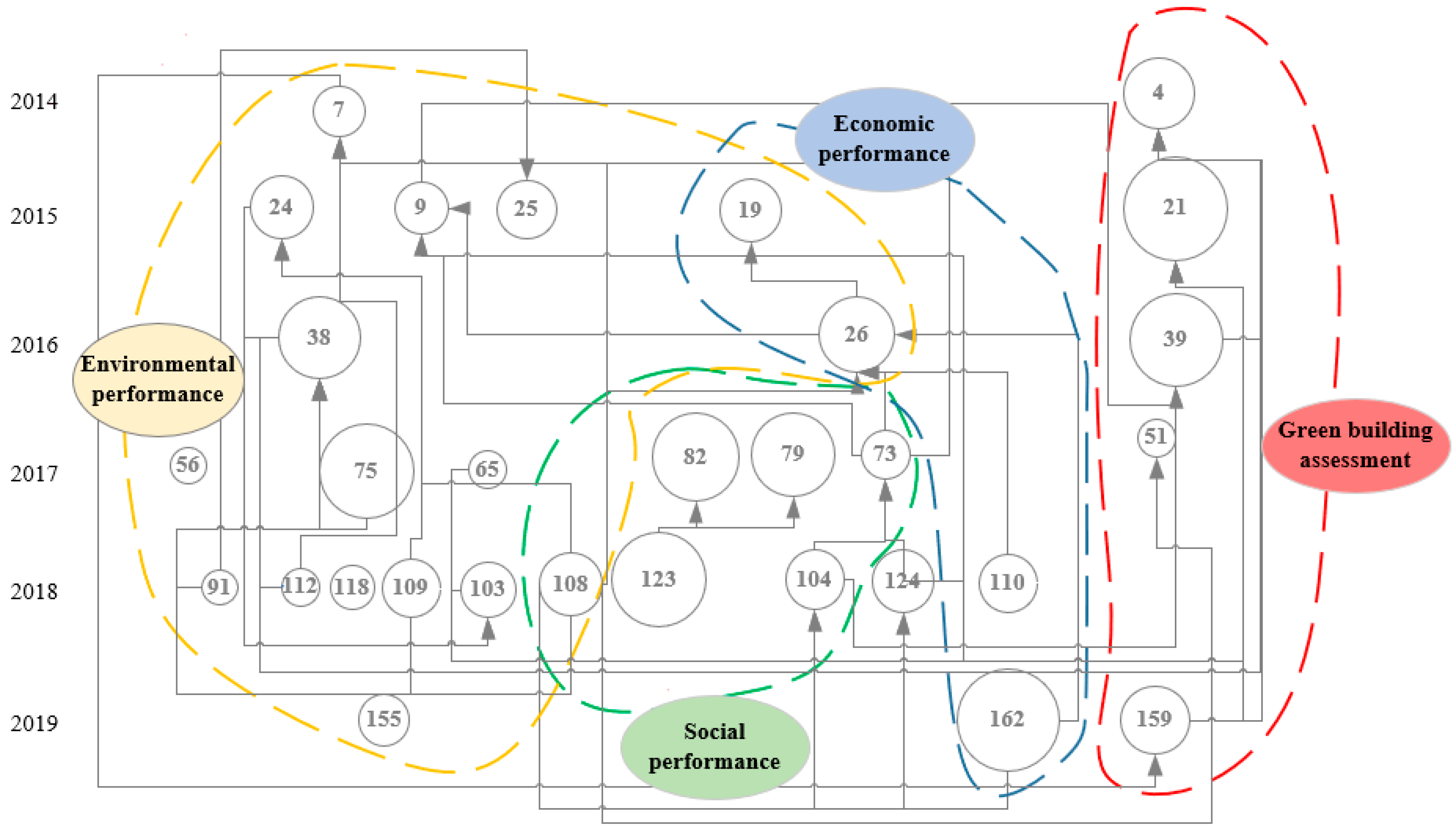
| No. | Authors | Number of Articles | Data Type | Tools | Findings |
|---|---|---|---|---|---|
| 1 | Ibem et al. [13] | 78 | Qualitative | -- * | The digital technologies applicable to construction procurement activities and their applications were reviewed. |
| 2 | Ansah et al. [5] | 43 | Qualitative | -- | The current application status of BIM in Green Building Assessment Schemes (GBASs) were summarized. |
| 3 | Chowdhury et al. [14] | 144 | Quantitative, qualitative | Excel | The main functions of digital technologies in construction productivity were reviewed and the potential methods for improvement were proposed. |
| 4 | Wang et al. [17] | 113 | Quantitative, qualitative | VOSviewer | The digital technologies used in off-site construction were summarized and their application limitations were analyzed. |
| 5 | Abioye et al. [15] | 1272 | Qualitative | -- | The AI tools used in building safety management were reviewed. |
| 6 | Opoku et al. [18] | 22 | Quantitative, qualitative | Excel | The application status and development potentials of digital twins in the design and construction stages were analyzed. |
| 7 | Luo et al. [16] | 108 | Qualitative | -- | The digital technologies employed in building quality management were summarized. |
| 8 | Olawumi et al. [19] | 82 | Quantitative, qualitative | VOSviewer | The digital technologies adopted in building quality management. |
| 9 | Cascone [20] | 54 | Qualitative | -- | BIM plugins for LEED certification were summarized and methods to improve BIM integration were proposed. |
| 10 | Trask et al. [21] | 24 | Qualitative | -- | The digital technologies in building safety management were identified. |
| 11 | Iyiola et al. [22] | 126 | Quantitative, qualitative | VOSviewer (version 1.6.20) | The digital technologies used in C & D management were reviewed and the implementation obstacles were discussed. |
| Search Clouds | Sustainable Construction | Digital Technologies |
|---|---|---|
| Keywords | Sustainable/sustainability architecture/construction/building, green building/construction, high-performance building, building environmental performance, ecological building/construction | Digital technologies, BIM, 3D printing, Building Energy Modeling (BEM), Virtual Reality (VR), AR (Augmented Reality), IoT, big data, blockchain, Artificial Intelligence (AI), digital twins, cloud computing |
| No. | Region | Frequency | Centrality | Institution | Frequency | Centrality |
|---|---|---|---|---|---|---|
| 1 | China | 324 | 0.25 | Hong Kong Polytechnic University | 47 | 0.31 |
| 2 | U.S. | 97 | 0.32 | Egyptian Knowledge Bank | 30 | 0.16 |
| 3 | England | 89 | 0.12 | Shenzhen University | 21 | 0.03 |
| 4 | Australia | 85 | 0.05 | Tongji University | 16 | 0.04 |
| 5 | Italy | 60 | 0.11 | Chongqing University | 15 | 0.04 |
| 6 | Spain | 52 | 0.06 | University of Sevilla | 14 | 0.00 |
| 7 | Saudi Arabia | 46 | 0.22 | University of Hong Kong | 14 | 0.01 |
| 8 | Canada | 42 | 0.05 | Nanyang Technological University | 14 | 0.04 |
| 9 | Malaysia | 38 | 0.10 | University of New South Wales Sydney | 13 | 0.07 |
| 10 | India | 35 | 0.05 | Prince Sattam Bin Abdulaziz University | 13 | 0.01 |
| Cluster ID | Cluster Label (LLR) | Size | Mean Year |
|---|---|---|---|
| 2 | Barriers | 38 | 2019 |
| 3 | Energy efficiency | 34 | 2019 |
| 4 | Building energy performance | 29 | 2015 |
| 5 | Life cycle assessment | 29 | 2019 |
| 6 | Computer vision | 29 | 2019 |
| 7 | Renovation | 29 | 2019 |
| 8 | Building sustainability assessment | 28 | 2018 |
| 9 | Management | 16 | 2017 |
| Category | Barriers | References |
|---|---|---|
| Social and organizational barriers |
| [30,31,32,33,34,35] |
| Financial barriers |
| [30,31,32,33,36] |
| Technical barriers |
| [30,31,32,33,34,35] |
| Data barriers |
| [31,36] |
| Stakeholder barriers |
| [30,31,32,37] |
| Legal barriers |
| [31,33,37] |
| Security barriers |
| [32,35,36,37] |
Disclaimer/Publisher’s Note: The statements, opinions and data contained in all publications are solely those of the individual author(s) and contributor(s) and not of MDPI and/or the editor(s). MDPI and/or the editor(s) disclaim responsibility for any injury to people or property resulting from any ideas, methods, instructions or products referred to in the content. |
© 2025 by the authors. Licensee MDPI, Basel, Switzerland. This article is an open access article distributed under the terms and conditions of the Creative Commons Attribution (CC BY) license (https://creativecommons.org/licenses/by/4.0/).
Share and Cite
Li, Y.; Zhao, X.; Liu, C.; Zhang, Z. Applications of Digital Technologies in Promoting Sustainable Construction Practices: A Literature Review. Sustainability 2025, 17, 487. https://doi.org/10.3390/su17020487
Li Y, Zhao X, Liu C, Zhang Z. Applications of Digital Technologies in Promoting Sustainable Construction Practices: A Literature Review. Sustainability. 2025; 17(2):487. https://doi.org/10.3390/su17020487
Chicago/Turabian StyleLi, Yuanyuan, Xiujuan Zhao, Chunlu Liu, and Zhigang Zhang. 2025. "Applications of Digital Technologies in Promoting Sustainable Construction Practices: A Literature Review" Sustainability 17, no. 2: 487. https://doi.org/10.3390/su17020487
APA StyleLi, Y., Zhao, X., Liu, C., & Zhang, Z. (2025). Applications of Digital Technologies in Promoting Sustainable Construction Practices: A Literature Review. Sustainability, 17(2), 487. https://doi.org/10.3390/su17020487







